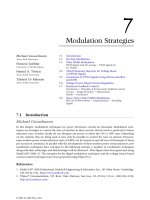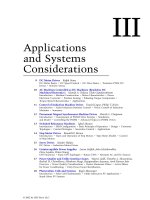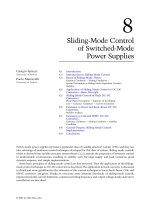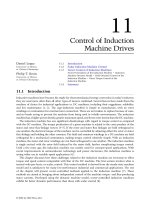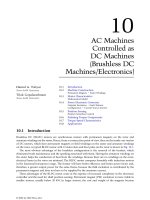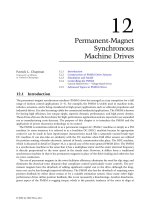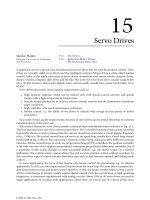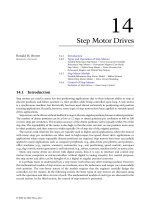newnes electrical power engineers handbook
Bạn đang xem bản rút gọn của tài liệu. Xem và tải ngay bản đầy đủ của tài liệu tại đây (6.99 MB, 477 trang )
Newnes Electrical
Power Engineer’s
Handbook
Second Edition
This page intentionally left blank
Newnes Electrical
Power Engineer’s
Handbook
Second Edition
D.F. Warne
AMSTERDAM BOSTON HEIDELBERG LONDON NEW YORK
OXFORD PARIS SAN DIEGO SAN FRANCISCO
SINGAPORE SYDNEY TOKYO
Newnes is an imprint of Elsevier
Newnes
An imprint of Elsevier
Linacre House, Jordan Hill, Oxford OX2 8DP
30 Corporate Drive, Burlington, MA 01803
First published 2005
Copyright © 2005, D.F. Warne. All rights reserved
The right of D.F. Warne to be identified as the author of this work
has been asserted in accordance with the Copyright, Designs and
Patents Act 1988
No part of this publication may be reproduced in any material form
(including photocopying or storing in any medium by electronic means
and whether or not transiently or incidentally to some other use of this
publication) without the written permission of the copyright holder except
in accordance with the provisions of the Copyright, Designs and Patents Act
1988 or under the terms of a licence issued by the Copyright Licensing
Agency Ltd, 90 Tottenham Court Road, London, England W1T 4LP.
Applications for the copyright holder’s written permission to reproduce any
part of this publication should be addressed to the publisher
Permissions may be sought directly from Elsevier’s Science and Technology
Rights Department in Oxford, UK: phone: (+44) (0) 1865 843830;
fax: (+44) (0) 1865 853333; e-mail: You may
also complete your request on-line via the Elsevier homepage
(), by selecting ‘Customer Support’ and
then ‘Obtaining Permissions’
British Library Cataloguing in Publication Data
A catalogue record for this book is available from the British Library
Library of Congress Cataloguing in Publication Data
A catalogue record for this book is available from the Library of Congress
ISBN 0 7506 6268 9
Printed and bound in Great Britain
For information on all Elsevier publications
visit our website at www.books.elsevier.com
Contents
Acknowledgements xvii
1 Introduction 1
2 Principles of electrical engineering 5
2.1 Nomenclature and units 5
2.2 Electromagnetic fields 5
2.2.1 Electric fields 5
2.2.2 Electric currents 7
2.2.3 Magnetic fields 9
2.2.4 Electromagnetism 11
2.3 Circuits 13
2.3.1 DC circuits 13
2.3.2 AC circuits 17
2.3.3 Magnetic circuits 21
2.4 Energy and power 22
2.4.1 Mechanical energy 22
2.4.2 Electrical energy 22
2.4.3 Per-unit notation 24
2.4.4 Energy transformation effects 25
3 Materials for electrical engineering 29
3.1 Introduction 29
3.2 Magnetic materials 29
3.2.1 Soft (high permeability) materials 31
3.2.1.1 Sheet steels 32
3.2.1.2 Amorphous alloys 33
3.2.1.3 Nickel iron alloys 34
3.2.1.4 Ferrites and garnets 34
3.2.1.5 Soft magnetic composites 35
3.2.2 Hard (permanent magnet) materials 35
3.2.2.1 Alnico alloys 35
3.2.2.2 Ferrites 35
3.2.2.3 Rare earth alloys 36
3.2.2.4 Bonded magnets 37
3.2.2.5 Applications 37
3.2.3 Other materials 38
3.2.4 Standards 39
3.3 Insulating materials 39
3.3.1 Solid dielectrics 41
3.3.1.1 Inorganic (ceramic and glass) materials 42
3.3.1.2 Plastic films 42
3.3.1.3 Flexible insulating sleeving 42
3.3.1.4 Rigid fibrous reinforced laminates 42
vi Contents
3.3.1.5 Resins and varnishes 43
3.3.1.6 Pressure-sensitive adhesive tapes 43
3.3.1.7 Cellulosic materials 43
3.3.1.8 Combined flexible materials 43
3.3.1.9 Mica products 43
3.3.1.10 Textile insulation 44
3.3.1.11 Elastomers and thermoplastics 44
3.3.2 Liquid dielectrics 46
3.3.3 Gas insulation 47
3.3.4 Vacuum insulation 48
3.3.5 Standards 48
3.4 Conducting materials 49
3.4.1 Conductors 49
3.4.1.1 Copper and its alloys 49
3.4.1.2 Aluminium and its alloys 53
3.4.1.3 Resistance alloys 54
3.4.2 Semiconductors 54
3.4.2.1 Impurity effects and doping 55
3.4.2.2 The transistor 57
3.4.2.3 Printed circuits and integrated circuits 58
3.4.2.4 The microprocessor 58
3.4.3 Superconductors 59
3.4.4 Standards 60
4 Measurements and instrumentation 63
4.1 Introduction 63
4.1.1 Definition of terms 63
4.1.2 Range, accuracy and error 63
4.1.3 Dynamic effects 64
4.1.4 Signals and standards 64
4.1.5 P&ID symbols 65
4.2 Pressure 65
4.2.1 The manometer 65
4.2.2 Elastic sensing elements 68
4.2.3 Piezo elements 68
4.3 Flow 70
4.3.1 Differential pressure flowmeters 70
4.3.2 Turbine flowmeters 72
4.3.3 Vortex shedding flowmeters 73
4.3.4 Electromagnetic flowmeters 74
4.3.5 Ultrasonic flowmeters 74
4.3.6 Mass flowmeters 75
4.4 Temperature 76
4.4.1 The thermocouple 76
4.4.2 The resistance thermometer 77
4.4.3 The pyrometer 77
4.5 Position 80
4.5.1 The potentiometer 80
4.5.2 The synchro and resolver 80
Contents vii
4.5.3 The linear variable differential transformer (LVDT) 82
4.5.4 The shaft encoder 82
4.5.5 The variable capacitance transducer 83
4.5.6 Laser distance measurement 84
4.5.7 Proximity switches and photocells 85
4.6 Level 85
4.6.1 The pressure-based system 85
4.6.2 Electrical probe 85
4.6.3 Ultrasonic transducers 86
4.6.4 Nucleonic methods 87
4.7 Weighing and force 88
4.7.1 Stress and strain 88
4.7.2 The strain gauge 89
4.7.3 Bridge circuits 89
4.7.4 The load cell 92
4.8 Acceleration and speed 92
4.8.1 Speed 92
4.8.2 Accelerometers and vibration transducers 93
4.9 Current 94
4.10 HART and Fieldbus 95
4.11 Data acquisition 96
4.12 Installation notes 102
5 Generators 105
5.1 Introduction 105
5.2 Main generator types 105
5.3 Principles of operation 107
5.3.1 No-load operation 107
5.3.2 The effect of load 112
5.3.3 Damping of transients 115
5.3.4 Voltage waveform 115
5.3.5 Connecting generators in parallel 117
5.3.6 Operating limits when in parallel with the mains 117
5.4 The Automatic Voltage Regulator (AVR) 118
5.5 Brushless excitation 119
5.5.1 Separate exciter 120
5.5.2 Capacitor excitation 122
5.5.3 Induction generator 123
5.5.4 Inductor alternator 125
5.6 Construction 126
5.6.1 Stator 126
5.6.2 Rotor 127
5.6.3 Cooling 128
viii Contents
5.7 Rating and specification 130
5.7.1 Rated output 130
5.7.2 Reactances 131
5.7.3 Main items of specification 131
5.8 Testing 132
5.9 Standards 133
6Transformers 135
6.1 Principles of operation 135
6.2 Main features of construction 139
6.2.1 The core 139
6.2.2 Windings 141
6.2.3 Winding connections 144
6.2.4 Bushings 148
6.2.5 Tapchangers 149
6.2.6 Cooling equipment 154
6.3 Main classes of transformer 154
6.3.1 Transformer for electronics 154
6.3.2 Small transformers 154
6.3.3 Distribution transformers 155
6.3.4 Supply transformers 156
6.3.5 Transmission (or intertie) transformers 156
6.3.6 Generator (or step-up) transformers 157
6.3.7 Phase-shifting transformers 157
6.3.8 Converter transformers 158
6.3.9 Railway transformers 160
6.3.10 Rectifier and furnace transformers 160
6.3.11 Dry-type transformers 160
6.3.12 Gas-filled transformers 160
6.4 Rating principles 161
6.4.1 Rated power 161
6.4.2 Overloading 162
6.4.3 Parallel operation of transformers 162
6.5 Test methods 162
6.5.1 Specification testing 162
6.5.2 In-service testing 165
6.6 Commissioning, maintenance and repair 166
6.6.1 Commissioning 166
6.6.2 Maintenance 167
6.6.3 Diagnostics and repair 167
6.7 Standards 167
7 Switchgear 169
7.1 Introduction 169
7.2 Principles of operation 170
Contents ix
7.3 Low-voltage switchgear 172
7.3.1 Switches, disconnectors, switch disconnectors and
fuse combination units 172
7.3.1.1 Construction and operation 172
7.3.1.2 Standards and testing 174
7.3.2 Air circuit breakers and moulded case circuit breakers 175
7.3.2.1 Construction and operation 175
7.3.2.2 Testing and standards 179
7.3.3 Miniature circuit breakers 180
7.3.4 Residual current devices 182
7.3.5 Standards 183
7.4 Medium-voltage (distribution) switchgear 184
7.4.1 Types of circuit breaker 184
7.4.2 Main classes of equipment 188
7.4.2.1 Primary switchgear 188
7.4.2.2 Secondary switchgear 191
7.4.3 Rating principles 192
7.4.4 Test methods 192
7.4.5 Commissioning and maintenance 197
7.4.6 Standards 197
7.5 High-voltage (transmission) switchgear 197
7.5.1 System considerations 197
7.5.2 Types of circuit breaker 199
7.5.3 Main classes of equipment 200
7.5.3.1 Conventional or Air-Insulated Switchgear (AIS) 201
7.5.3.2 Gas-insulated metal-enclosed switchgear 201
7.5.3.3 Hybrid substations 203
7.5.4 Rating principles 204
7.5.5 Test methods 205
7.5.6 Commissioning and maintenance 206
7.5.7 Standards 207
7.6 DC switchgear 207
7.6.1 Technology and applications 207
7.6.2 Semiconductor circuit breakers 208
7.6.3 Air circuit breakers 209
7.6.4 DC traction fault duties 213
7.6.5 DC traction protection 213
7.6.6 Safety features and interlocking 215
7.6.7 Applicable standards and testing 216
8 Fuses and protection relays 219
8.1 Protection and co-ordination 219
8.2 Fuses 221
8.2.1 Principles of design and operation 221
8.2.2 Rating principles and properties 224
8.2.3 Main classes of equipment 227
8.2.4 Test methods 231
8.2.5 Standards 232
x Contents
8.3 Protection relays 233
8.3.1 Principles of design and operation 233
8.3.2 Rating principles and properties 238
8.3.3 Main classes of relay 240
8.3.4 Test methods 243
8.3.5 Standards 243
9Wires and cables 247
9.1 Scope 247
9.2 Principles of power cable design 247
9.2.1 Terminology 247
9.2.2 General considerations 248
9.2.3 Paper-insulated cables 249
9.2.4 Polymeric cables 250
9.2.5 Low Smoke and Fume (LSF) and fire performance cables 252
9.3 Main classes of cable 253
9.3.1 Cables for the electricity supply industry 253
9.3.1.1 MV paper-insulated cables 253
9.3.1.2 MV polymeric cables 254
9.3.1.3 LV polymeric cables 257
9.3.2 Industrial cables 259
9.3.2.1 Paper-insulated cables 259
9.3.2.2 Polymeric cables for fixed installations 260
9.3.2.3 Polymeric cables for flexible connections 261
9.3.3 Wiring cables 262
9.4 Parameters and test methods 263
9.4.1 Current rating 264
9.4.2 Capacitance 264
9.4.3 Inductance 265
9.4.4 Voltage drop 265
9.4.5 Symmetrical and earth fault capacity 266
9.5 Optical communication cables 267
9.5.1 Optical fibres 267
9.5.2 Optical cable design 268
9.5.3 Interconnections 272
9.5.4 Installation 275
9.6 Standards 276
9.6.1 Metallic wires and cables 276
9.6.2 Optical communication cables 277
10 Motors, motor control and drives 279
10.1 Introduction 279
10.2 The direct current (DC) motor 280
10.3 The cage induction motor 284
10.3.1 Torque characteristics 285
Contents xi
10.3.2 Voltage–frequency relationship 287
10.3.3 Flux vector control 289
10.4 The slipring induction motor 290
10.5 The ac synchronous motor 290
10.6 The brushless servomotor 291
10.6.1 Stationary torque characteristics 292
10.7 The reluctance motor 293
10.8 The switched reluctance motor 293
10.9 Mechanical and duty cycle considerations 295
10.9.1 Mounting of the motor 295
10.9.2 Degree of protection 296
10.9.3 Duty cycles 296
10.10 Drive power circuits 297
10.10.1 DC motor drive systems 298
10.10.1.1 AC to dc power conversion 298
10.10.1.2 Single-converter drives 300
10.10.1.3 Dual-converter drives 301
10.10.1.4 Field control 302
10.10.1.5 DC to dc power conversion 302
10.10.2 AC motor drive systems 305
10.10.2.1 AC to ac power converters with
intermediate dc link 305
10.10.2.2 General characteristics of a voltage
source inverter 306
10.11 Effects of semiconductor power converters 307
10.11.1 Effects upon dc machines 307
10.11.2 Effects upon ac machines 308
10.11.2.1 Machine rating: thermal effects 308
10.11.2.2 Machine insulation 308
10.11.2.3 Bearing currents 309
10.12 The commercial drive 309
10.13 Standards 311
11 Power electronic circuits and devices 313
11.1 Introduction 313
11.2 Diode converters 313
11.2.1 Three-pulse rectifier 313
11.2.2 Six-pulse rectifier 315
11.2.3 Characteristics of the six-pulse input current 315
11.2.4 Twelve-pulse rectifier with delta–star transformer 318
11.2.5 Controlled rectifiers 321
11.3 Active devices 323
11.3.1 Inductive switching waveforms 324
xii Contents
11.4 Principles of switching circuits 324
11.4.1 DC–DC converters 324
11.4.2 Two- and four-quadrant converters 326
11.4.3 Three-phase inverter 329
11.4.4 Sinusoidal Pulse Width Modulation (PWM) 330
11.5 High-frequency power supplies 332
11.5.1 Forward converter 334
11.5.2 Flyback converter 335
11.6 Standards 338
12 Batteries and fuel cells 339
12.1 Introduction 339
12.2 Primary cells 340
12.2.1 Zinc carbon 340
12.2.2 Alkaline manganese 340
12.2.3 Mercury oxide 340
12.2.4 Silver oxide 341
12.2.5 Zinc air 341
12.2.6 3 V lithium primary batteries 342
12.2.7 Lithium thionyl chloride 344
12.2.8 1.5 V lithium primary batteries 346
12.3 Secondary cells based upon aqueous electrolytes 346
12.3.1 Sealed nickel cadmium 348
12.3.2 Vented nickel cadmium 349
12.3.3 Nickel metal hydride 350
12.3.4 Lead acid – pasted plate 351
12.3.5 Lead acid – tubular 351
12.3.6 Lead acid – Plante´ 352
12.3.7 Lead acid – valve regulated sealed (VRSLA) 353
12.4 Secondary lithium ion cells 355
12.4.1 Lithium ion batteries 355
12.4.2 Lithium polymer batteries 356
12.5 Fuel cells 356
12.5.1 The Polymer Electrolyte Fuel Cell (PEFC) 357
12.5.2 The Solid Oxide Fuel Cell (SOFC) 358
12.6 Battery charging 359
12.6.1 Small commercial batteries (up to 10 Ah) 359
12.6.2 Automotive batteries 359
12.6.3 Motive power 361
12.6.4 Standby power applications 363
12.7 Battery monitoring 367
12.7.1 Load-discharge testing 367
12.7.2 dV/dt-load testing 367
12.7.3 Computer monitoring of cell voltages 369
12.7.4 Conductance monitoring 369
Contents xiii
12.8 Installation, testing and commissioning 371
12.9 Operation and maintenance 372
12.9.1 Primary cells 372
12.9.2 Secondary cells 372
12.10 Standards 373
13 The power system 375
13.1 Introduction 375
13.2 Generation 375
13.2.1 Distributed and renewable generation 376
13.3 Transmission 376
13.3.1 Principles of design 380
13.3.1.1 HVDC transmission 381
13.3.1.2 AC system compensation 382
13.3.1.3 FACTS devices 383
13.3.2 System operation 384
13.4 Distribution 385
13.4.1 System design 387
13.4.2 System operation 388
13.5 De-regulation and privatization 389
13.6 Future trends 389
14 Power quality and electromagnetic compatibility 391
14.1 Power quality 391
14.1.1 Introduction 391
14.1.2 What determines power quality 391
14.1.3 Supply characteristics 392
14.1.4 Key parameters 392
14.1.5 Common problems 395
14.1.5.1 Harmonic voltage and current distortion 395
14.1.5.2 Voltage dips 396
14.1.6 Monitoring 396
14.2 Electromagnetic compatibility 397
14.2.1 Introduction 397
14.2.1.1 Sources 397
14.2.1.2 Coupling mechanisms 398
14.2.1.3 Equipment sensitivity 398
14.2.2 Simple source models 398
14.2.2.1 Receptor efficiency 400
14.2.3 Signal waveforms and spectra 400
14.2.4 EMC limits and test levels 403
14.2.4.1 Emissions 403
14.2.4.2 Immunity 404
14.2.5 Design for EMC 406
14.2.5.1 Basic concepts 406
14.2.5.2 Shielding 408
14.2.5.3 Cable screens termination 408
14.2.5.4 PCB design and layout 408
14.2.5.5 Grounding 410
14.2.5.6 Systems and installations 411
14.2.6 Measurements 411
14.2.6.1 Emissions 411
14.2.6.2 Immunity 412
14.3 Standards 413
14.3.1 Generic standards 413
14.3.2 Important product standards 413
14.3.3 Basic standards 414
15 Electricity and potentially explosive atmospheres 415
15.1 Introduction 415
15.2 EU directives 415
15.3 UK legislation 416
15.4 Area classification 416
15.4.1 Codes of practice for area classification 417
15.5 Hazardous area equipment 419
15.5.1 Methods of protection 419
15.5.2 Temperature classes and apparatus groups 419
15.5.3 Equipment marking 422
15.6 Equipment selection 423
15.7 Equipment installation 424
15.7.1 Protection from sparking 424
15.7.2 Electrical protection 425
15.7.3 Means of isolation 425
15.7.4 Wiring systems 425
15.7.5 Flameproof equipment 425
15.7.5.1 Solid obstacles 425
15.7.5.2 Protection of flamepaths 427
15.7.5.3 Cable entries 427
15.7.5.4 Motors with variable frequency supply 427
15.7.5.5 Conduit systems 429
15.7.6 Increased safety equipment 429
15.7.6.1 Cable and conduit entries 429
15.7.6.2 Wiring terminations 429
15.7.6.3 Wiring within enclosures 430
15.7.6.4 Thermal protection of electrical machines 430
15.7.7 Intrinsic safety equipment 430
15.7.8 Pressurized apparatus 431
15.7.9 Type n equipment 431
15.7.10 Personal electrical apparatus 432
xiv Contents
Contents xv
15.8 Inspection and maintenance 432
15.8.1 Inspection strategy 432
15.8.2 Inspection schedules 433
15.8.3 General requirements 433
15.8.3.1 Withdrawal from service 433
15.8.3.2 Isolation 433
15.8.3.3 Fault loop impedance or earth resistance 433
15.8.3.4 Insulation resistance measurements 434
15.8.3.5 Overloads 434
15.8.4 Specific requirements 434
15.8.4.1 Flameproof equipment 434
15.8.4.2 Increased safety 434
15.8.4.3 Intrinsic safety 434
15.8.5 Maintenance 434
16 Principles of electrical safety 437
16.1 Injuries from electricity 437
16.1.1 Electric shock 437
16.1.2 Contact and internal burns 439
16.1.3 Arc and flashover burns 439
16.1.4 Fire injuries 440
16.1.5 Explosion injuries 440
16.2 Precautions against electric shock and contact burn injuries 440
16.2.1 General principles 440
16.2.2 Prevention of direct contact injuries 440
16.2.2.1 Insulation and enclosures 440
16.2.2.2 Safe by position 441
16.2.2.3 Reduced voltage 441
16.2.2.4 Extra-low voltage 442
16.2.2.5 Limitation of energy 442
16.2.2.6 Electrical separation 442
16.2.2.7 Earth leakage protection 442
16.2.3 Prevention of indirect contact injuries 443
16.3 Precautions against arc and flashover burn injuries 444
16.4 Precautions against fire 444
16.5 Precautions against explosions 445
16.6 Preventive maintenance and safe systems of work 445
16.6.1 Preventive maintenance 445
16.6.2 Safe systems of work 445
16.6.2.1 Safe isolation procedures 445
16.6.2.2 Live working practices 446
16.7 Standards 447
Index 449
This page intentionally left blank
Acknowledgements
When I was first asked to update the Newnes Electrical Engineer’s Handbook, it seemed
a relatively straightforward task. But after studying the reviewer’s comments which
had been assembled by the publisher it became clear that a number of changes
in emphasis would be worthwhile. It was also evident that in North America, a clearer
distinction has to be made between electrical power engineering and electronics. Since
the main target of this book is electrical power equipment, a change of title was agreed
and so we now have the Newnes Electrical Power Engineer’s Handbook.
At the same time, some areas of the technology continue to advance apace, partic-
ularly in the structure and operation of power systems, and in emc and power quality.
So some chapters needed a substantial overhaul even though the Newnes Electrical
Engineer’s Handbook was published only five years ago.
New contributors have been introduced to handle the various updates, partly because
of the retirement of former contributors and partly because of change of emphasis. The
co-operation of all the contributors during the preparation of material and through the
inevitable differences of pace at which the different sections have been completed, is
gratefully acknowledged.
Every work of this type consumes a vast amount of time, with an inevitable sacri-
fice of personal and social time. Without the patience and understanding of my wife
Gill, the completion of the project would have been much more difficult. Her support
in this, as in all our ventures, is lovingly acknowledged.
D.F. Warne
October 2004
This page intentionally left blank
Chapter 1
Introduction
In many countries the public perception of more traditional aspects of engineering
remains at best indifferent and at worst quite negative. Electrical engineering is per-
haps seen as mature, unchanging and offering little scope for imagination, with poor
prospects for any future career. There is a serious risk in many parts of Europe and
North America that substantial areas of knowledge are being lost as large numbers
of key experts are retiring without the opportunity to teach and train the specialists
of the future. And yet the technology continues to move on, and the understanding of
the basic mechanisms of circuits, electromagnetics and dielectrics continues to be as
challenging intellectually as it has ever been. There have even been very prominent
warnings of the dangers of neglecting the importance of electrical power systems and
plant, and of underestimating the value of the skilled engineers necessary to support
this infrastructure. The major power failures of the past few years, in the Eastern
seaboard of the USA, in Auckland, in Italy, in London and in parts of Scandinavia have
highlighted how dependent a modern society is on a reliable source of electrical
energy.
So, the need has never been stronger for a basic understanding of principles and
a fundamental appreciation of how the major classes of electrical equipment operate.
In a handbook, it is not possible to set out a comprehensive treatment but the aim is to
provide a balanced overview, and perhaps to engender the interest to pursue areas in
more depth. A more complete coverage of all the subjects addressed here can be found
in the Newnes Electrical Engineer’s Reference Book.
The structure of the handbook is, as before, based around three groups of chapters
as follows:
•
fundamentals and general material
•
the design and operation of the main classes of electrical equipment
•
special technologies which apply to a range of equipment
The first group covers the fundamentals and principles which run through all aspects
of electrical power technology.
The opening chapter deals with the fundamentals of circuit theory and electric and
magnetic fields, together with a brief coverage of energy conversion principles.
This is followed by a review of the materials which are crucial to the design and
operation of electrical equipment. These are grouped under the headings of magnetic,
insulating and conducting materials. In each of these areas, technology continues to
move ahead. Further improvement in the performance of permanent magnets is one of
the key drivers behind the increasing use of electrical actuators and drives in cars and
the miniaturization of whole ranges of domestic and commercial equipment; and the
challenges in understanding the behaviour of soft magnetic materials, especially under
conditions of distorted supply waveforms, are gradually being overcome. Developments
in insulating materials mean that increased reliability can be achieved, and operation
at much higher temperatures can be considered. Under the heading of conductors, there
are continuing advances in superconductors, which are now able to operate at liquid
nitrogen temperatures, and of course semiconductor developments continue to trans-
form the way in which equipment can be controlled.
Finally, in this opening group there is a chapter on measurement and instrumenta-
tion. Modern equipment and processes rely increasingly on sensors and instrumentation
for control and for condition assessment and diagnostics, so in this chapter there are
some changes in coverage, the emphasis now being on sensors and the way in which
signals from sensors may be processed.
The next group of eight chapters form the core of the book and they cover the essen-
tial groups of electrical equipment found today in commerce and industry.
The opening five chapters here cover generators, transformers, switchgear, fuses
and wires and cables. These are the main technologies for the production and handling
of electrical power, from generation, transmission and distribution at high voltages and
high powers down to the voltages found in factories, commercial premises and house-
holds. Exciting developments include the advances made in high-voltage switchgear
using SF
6
as an insulating and arc-extinguishing medium, the extension of polymer
insulation into high-voltage cables and the continuing compaction of miniature and
moulded-case circuit breakers. A new section in the wires and cables chapter addresses
the growing technology of optical fibre cables. Although the main use for this tech-
nology is in telecommunications, which is outside the scope of the book, a chapter on
wires and cables would not be complete without it and optical fibres have in any case
found a growing number of applications in electrical engineering.
The following four chapters describe different groups of equipment which use or
store electrical energy. Probably the most important here is electric motors and drives,
since these use almost two-thirds of all electrical energy generated. Power electronics
is of growing importance not only in the conversion and conditioning of power, most
notably in variable-speed motor drives, but also in static power supplies such as emer-
gency standby, and in high-voltage applications in power systems. The range of bat-
teries now available for a variety of applications is extensive and a chapter is set aside
for this, including the techniques for battery charging and the emerging and related
technology of fuel cells. If fuel cells fulfil their promise and start to play a greater part
in the generation of electricity in the future then we can expect to see this area grow,
perhaps influencing the generator and power systems chapters in future editions of the
handbook.
The final group of four chapters covers subjects which embrace a range of tech-
nologies and equipment. There is a chapter on power systems which describes the way
in which generators, switchgear, transformers, lines and cables are connected and con-
trolled to transmit and distribute our electrical energy. The privatization of electricity
supply in countries across the world continues to bring great changes in the way the
power systems are operated, and these are touched upon here, as is the growing impact
of distributed generation. The second chapter in this group covers the connected sub-
jects of electromagnetic compatibility and power quality. With the growing number of
electronically controlled equipment in use today, it is imperative that precautions are
taken to prevent interference and it is also important to understand the issues which are
raised by the resulting disturbances in power supply, such as harmonics, unbalance, dips
and sags. The next chapter describes the certification and use of equipment for opera-
tion in hazardous and explosive environments; this covers a wide range of equipment
and several different classes of protection. And finally, but perhaps most importantly,
a chapter on health and safety has been added for this edition; this issue rightly pervades
2 Introduction
most areas of the use of electrical power and this topic is a valuable addition to the
handbook.
In most chapters there is a closing section on standards, which influence all aspects
of design, specification, procurement and operation of the equipment. At the highest
level are the recommendations published by the International Electrotechnical
Commission (IEC), which are performance standards, but they are not mandatory
unless referred to in a contract. Regional standards in Europe are Euro-Norms (ENs)
or Harmonized Documents (HDs) published by the European Committee for
Electrotechnical Standardization (CENELEC). CENELEC standards are part of
European law and ENs must be transposed into national standards and no national
standard may conflict with an HD. Many ENs and HDs are based on IEC recommen-
dations, but some have been specifically prepared to match European legislation
requirements such as EU Directives. National standards in the UK are published by
the British Standards Institution (BSI). BSI standards are generally identical to IEC
or CENELEC standards, but some of them address issues not covered by IEC or
CENELEC. In North America, the main regional standards are published by the
American National Standards Institute (ANSI) in conjunction with the Institute of
Electrical and Electronics Engineers (IEEE). The ANSI/IEEE standards are generally
different from IEC recommendations, but the two are becoming closer as a result of
international harmonization following GATT treaties on international trade. Coverage
of all these groups is attempted in the tables listing the key standards.
Newnes Electrical Power Engineer’s Handbook 3
This page intentionally left blank
